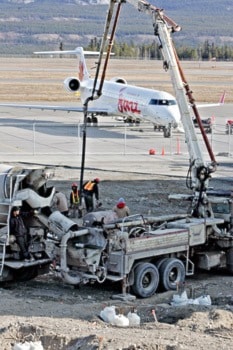Stricter landing rules at the Erik Nielsen Whitehorse International Airport coincided with the loss of a landing beacon in Porter Creek.
The beacon was “on a valuable piece of land,” said Whistle Bend city planner Kinden Kosick.
It was on land set to become part of the new subdivision.
So, the city and the Yukon government approached Nav Canada to see if it could be taken down.
Nav Canada did an internal study “and decided it was not needed,” said Kosick.
But as soon as the study was completed - and the beacon was decommissioned - the rules changed.
With the beacon in place, Air North and Air Canada could land from the north with a 183-metre ceiling and 2.8 kilometres of visibility.
Now, planes can only come in for a landing from the north if there’s a 396-metre ceiling and 4.8 kilometres of visibility.
Landings from the south rely on different instruments and are not affected.
The changes have nothing to do with the loss of the beacon, said Nav Canada spokesperson Ron Singer.
“But it seems like an awful coincidence,” said Air North president Joe Sparling.
“The (landing) approach went up coincidently with decommissioning the beacon.”
New regulations are being rolled out across the country, on a cyclical basis, said Singer.
When Whitehorse underwent its regulatory review, it looked at “operations, changes in terrain and new buildings,” said Singer.
That’s when the rules got stricter.
“The beacon was decommissioned at the same time, but had nothing to do with it,” he added.
To decommission the beacon, Community Services entered into a contract with Nav Canada to relocate it, said Pat Molloy, its director of infrastructure and development.
The new beacon is at the airport, he said.
But it hasn’t helped with Nav Canada’s stricter regulations.
Over the last year, other airports in mountainous terrain have also been undergoing Nav Canada reviews and have had their landing rules tightened, said Singer, mentioning Terrace, Kelowna and Kamloops.
By March, Nav Canada hopes to have a new Whitehorse landing path worked out for northern approaches.
This would bring landing restrictions back down to old levels.
But, in the interim, the new restrictions are expected to delay and cancel a lot of flights this winter.
“They are working to develop another approach to get the limits back down,” said Sparling.
But it would have been nice if Nav Canada had the alternate approach in place before it changed the landing restrictions in the first place, he said.
“Then there wouldn’t have been any flight disruptions.”
Creating an alternate approach takes time, said Singer.
There are “instrument procedure designs” to be done, “terrain to be cleared,” and “safe, flyable optical” procedures to carry out, he said.
“It’s very complex.”
Air North is not the only airline worried about the stricter regulations.
“The new approach criteria could impact operations in certain weather conditions,” wrote Air Canada spokesperson Debra Williams in an e-mail.
“We will only operate when and where it is safe to do so.”
There are not a lot of days each year when weather forces planes to land from the north, instead of the usual southern approach.
But with the new regulations, when weather does force a northern approach, the tougher regulations could make it impossible to land.
“And if those days happen to occur when you’re flying, that’s a problem,” said Sparling.
“And if they happen to occur over Christmas, that’s a problem.”
Contact Genesee Keevil at
gkeevil@yukon-news.com
